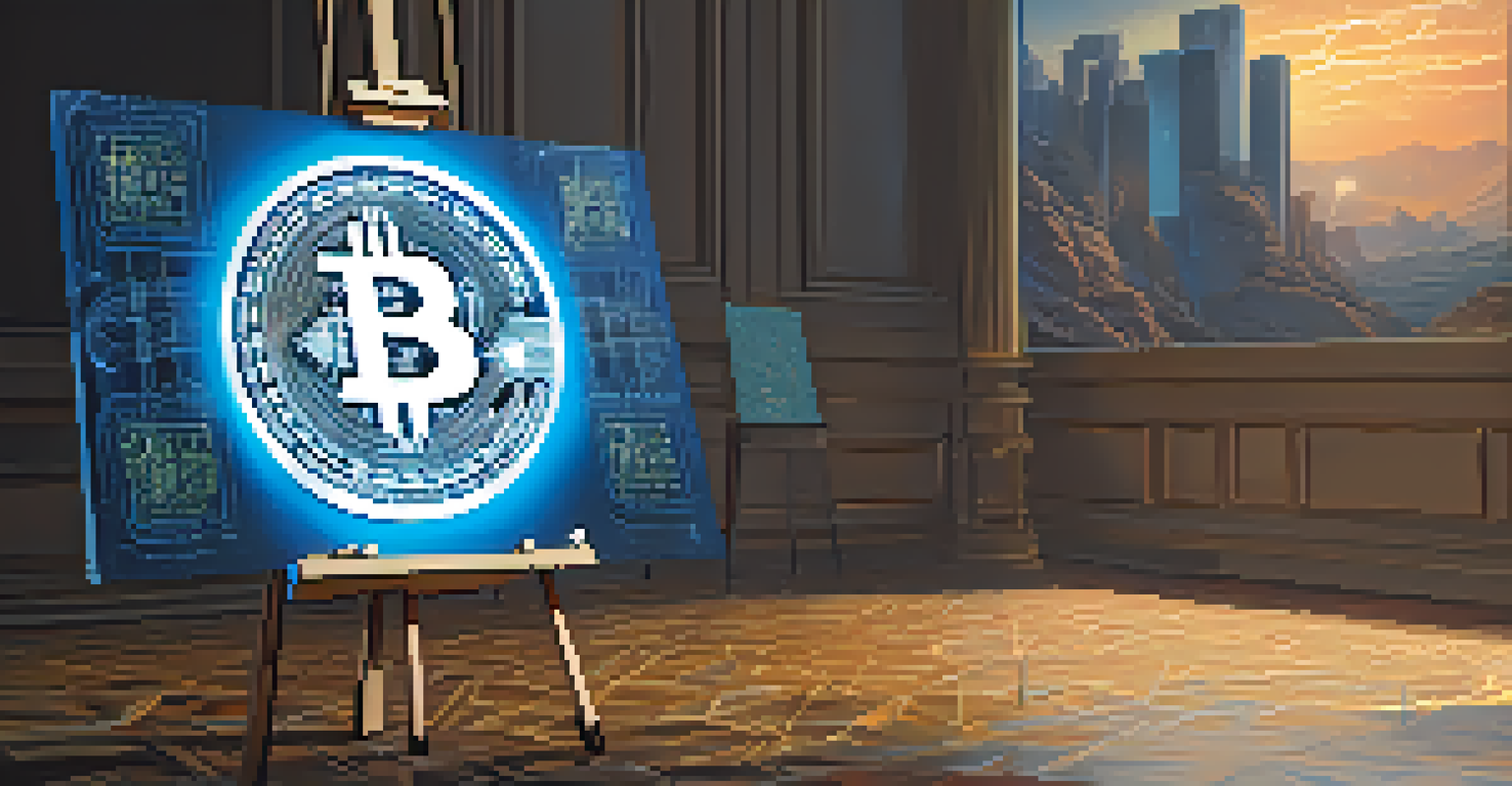The Impact of Cryptocurrency on Art Valuation and Appraisal

Understanding Cryptocurrency and Its Appeal
Cryptocurrency, like Bitcoin and Ethereum, is a digital asset that uses blockchain technology for secure transactions. Its appeal stems from its decentralized nature, allowing users to buy, sell, and trade without traditional banks. This innovation not only attracts investors but also artists, as it provides new avenues for monetizing their work.
The future of art is not a static canvas; it's a dynamic interplay of technology and creativity.
The allure of cryptocurrency goes beyond investment; it represents a cultural shift toward digital ownership. Artists can now create and sell digital art as NFTs (non-fungible tokens), which are unique digital certificates of ownership. This has opened up a whole new market for creators, allowing them to reach global audiences instantly.
As artists embrace this technology, the art world is transforming. The intersection of art and cryptocurrency is generating discussions about value, ownership, and authenticity, redefining how we think about art in the digital age.
The Role of NFTs in Art Valuation
Non-fungible tokens, or NFTs, have emerged as a revolutionary way to value digital art. Unlike cryptocurrencies like Bitcoin, which are interchangeable, NFTs are unique and cannot be replicated, making them perfect for representing ownership of digital artworks. This uniqueness is crucial in establishing value in the art market.

For example, a digital artwork sold as an NFT can fetch millions, as seen in the case of Beeple's 'Everydays: The First 5000 Days', which sold for $69 million. This sale not only highlights the potential of NFTs but also raises questions about how we appraise art in a world where digital ownership is becoming increasingly significant.
NFTs Revolutionize Digital Art
Non-fungible tokens (NFTs) provide unique ownership of digital art, establishing new methods of valuation in the art market.
As more artists and collectors engage with NFTs, traditional methods of valuation are being challenged. Art appraisers must adapt to this new landscape, considering not just the physical artwork but the digital certificates that accompany them.
Challenges in Valuing Digital Art
Valuing digital art presents unique challenges, primarily due to its intangible nature. Unlike traditional art, which can be physically examined, digital art exists solely in the virtual realm, complicating the appraisal process. This raises the question: how do you assess the worth of something that is easily replicated?
In the world of digital art, the value lies not just in the piece itself, but in the story and the technology behind it.
Another challenge is the volatility of cryptocurrency itself. The value of an artwork sold in Bitcoin, for instance, can fluctuate dramatically within a short period. This instability can lead to discrepancies in valuation, making it difficult for artists and collectors to agree on a fair price.
Moreover, the lack of established market standards for digital art adds to the complexity. As the market continues to evolve, appraisers need to develop new methodologies that incorporate both the uniqueness of digital assets and the inherent risks of cryptocurrency.
The Influence of Market Trends on Art Valuation
Market trends play a significant role in how art is valued, especially within the cryptocurrency space. The rise of interest in digital art and NFTs has led to a surge in prices, reflecting a broader cultural acceptance of these new mediums. Trends can be influenced by celebrity endorsements, social media buzz, and even economic conditions.
For instance, when high-profile artists or celebrities enter the NFT space, it can drive prices up significantly. This trend is reminiscent of the traditional art market, where the reputation of an artist can heavily influence the perceived value of their work. Understanding these trends is crucial for appraisers and collectors alike.
Challenges in Valuing Digital Art
Valuing digital art is complicated by its intangible nature and the volatility of cryptocurrency, necessitating new appraisal methodologies.
As the market matures, it’s essential for those involved to stay informed about these trends. Regularly monitoring shifts in buyer behavior and digital asset popularity will help in making informed decisions regarding valuation and investment.
The Impact of Decentralized Platforms on Appraisal
Decentralized platforms, particularly those built on blockchain technology, are changing the way art is bought and sold. These platforms allow artists to sell directly to buyers without intermediaries, potentially increasing their earnings. This shift also affects how art is appraised, as traditional gatekeepers may lose influence.
By removing intermediaries, decentralized platforms give rise to a more democratic art market. Artists from diverse backgrounds can showcase their work, leading to a wider range of styles and valuations. This diversity challenges conventional appraisal methods, pushing for more inclusive criteria that reflect the broader spectrum of artistic expression.
However, while these platforms offer new opportunities, they also introduce complexities in terms of valuation standards. As these platforms proliferate, appraisers will need to navigate a landscape that is both innovative and unpredictable.
Legal Considerations in Art Valuation with Crypto
The intersection of art, cryptocurrency, and legal frameworks is an area that is rapidly evolving. As digital art and NFTs gain popularity, legal considerations regarding ownership, copyright, and intellectual property become increasingly important. Artists and collectors must navigate these waters carefully to protect their investments.
For example, the question of copyright for digital art sold as an NFT can be murky. Who owns the rights to the image once it’s sold? Understanding the legal implications is crucial for appraisers, as these factors can significantly influence an artwork's value.
Legal Issues in Crypto Art
The rise of cryptocurrency and NFTs brings complex legal considerations regarding ownership and copyright that impact art valuation.
As laws continue to develop around cryptocurrency and digital assets, staying informed is essential. Art professionals must keep abreast of changes to ensure that their appraisals reflect not just market value, but also legal standing.
The Future of Art Valuation in a Crypto-Driven World
Looking ahead, the future of art valuation will likely be shaped by the continued integration of cryptocurrency and blockchain technology. As more artists and collectors embrace digital mediums, traditional valuation methods may need to evolve or risk becoming obsolete. This shift could lead to new appraisal methodologies that account for the unique characteristics of digital art.
We may see the emergence of hybrid models that combine traditional appraisal techniques with insights from the digital realm. This could involve utilizing data analytics to assess market trends and buyer behavior, offering a more comprehensive view of an artwork's value.

Ultimately, the art world stands on the brink of a transformative era. As cryptocurrency continues to influence art valuation, both artists and appraisers will need to adapt and innovate, ensuring they remain relevant in this dynamic landscape.